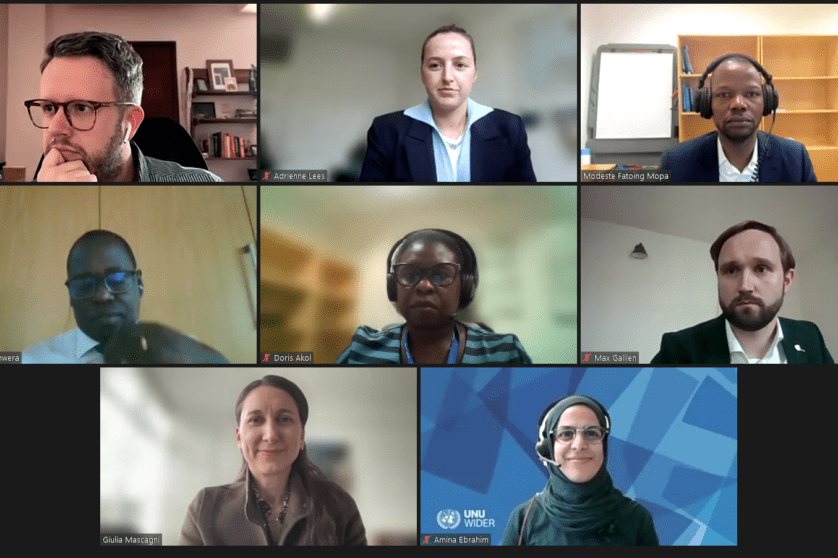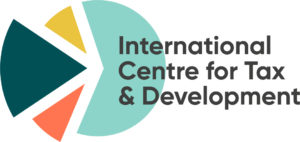How much tax can low-income countries feasibly raise? This has become a key question in light of rising debt costs and the substantial capital needed to tackle climate change and achieve the Sustainable Development Goals. Recent years have seen some highly ambitious estimates in contrast to relatively limited growth in tax-to-GDP ratios. However, a recent ICTD policy brief warned against these overly zealous tax targets which can be counterproductive to tax administrations and, instead, suggested five concrete ways to set better targets.
Against this backdrop the International Centre for Tax and Development (ICTD) hosted on Wednesday, April 17, 2024, a webinar on ‘Getting Targets Right – How much tax can low-income countries raise?’ with a panel of researchers and practitioners to discuss whether optimistic tax targets are helpful or hurtful and how to make them better.
The event was moderated by ICTD Research Director, Giulia Mascagni and kicked off with a presentation by ICTD Research Fellow, Max Gallien and Research Officer, Adrienne Lees who authored the aforementioned policy brief.
Panellists summarised their arguments and contributions below:
Doris Akol, Senior Economist, IMF
‘Tax targets enable the expansion of tax potential. They are useful in the design or redesign of the tax system to plug loopholes or broaden the tax base. When used well, especially in the context of medium-term reforms and institutional strengthening of revenue administrations, they can create some “healthy pressure” by stretching the revenue collection potential of revenue administrations. Tax targets allow policymakers to measure the effort of the tax system. It is important to use benchmarks which can be understood across the board, and which can be measured using similar and commonly understood metrics. This is why the tax-to-GDP ratio is commonly used as a performance metric for increased tax capacity, especially in low income developing countries (LIDCs).
However, I agree with ICTD’s policy brief that slow growth in the tax-to-GDP ratio is often used as evidence of under performance by the revenue administration. This is quite misleading because growth in the GDP may sometimes not be reflected in the tax take. This is usually on account of growth in the GDP contribution of sectors that command a significant component of the GDP but which are not taxed and thus not reflected in increased tax collection. That is why it is important for revenue administrations to adopt other metrics that can be used to measure productivity of their revenue administration as additional targets. These include year-on-year growth in major revenue sources and improvements in performance indicators of core tax processes that are usually measured by the Tax Administration Diagnostic Assessment Tool (TADAT).
Tax targets should reflect or take into account the impact of major reforms on the tax capacity of countries; hence tax targets are useful in justifying the sourcing of capacity development and important revenue administrations reforms (e.g. digitalisation, segmentation, or fiscalisation, and often in the context of formulation of medium-term reform strategies).
When done badly, relying on tax targeting as the only metric for performance of revenue institutions may lead to unhealthy tax collection behaviour, such as front-loading collection of tax that is not due, or disproportionate use of enforcement in revenue collection which could culminate in unhealthy tax bargaining and citizen discontent, fracturing the socio-fiscal contract.’
Bernard Baimwera, Dean, Kenya School of Revenue Administration
‘There is no doubt that LIDCs collect less revenue than their tax capacity. Improved tax capacity can however greatly help these countries grow their economies and achieve sustainable development. Most do have significant tax potential, which remains unexploited owing to a myriad of challenges related to their economic structures and tax administration. The lingering question is therefore how to exploit this untapped tax revenue potential for LIDCs and position them on a more promising tax revenue pathway especially that sustaining tax capacity growth is one of their key challenges.
Most of these countries, especially in sub-Saharan Africa, have not, for a long time, been able to meet their set revenue targets. For instance, Kenya only met its target in 2022, after a 14-year hiatus and following significant investments in an array of fiscal policies and administrative measures to increase revenue collection. Moreover, Kenya’s tax-to-GDP ratio decreased from 18.1 percent in the 2013/14 financial year to 14.1 percent in 2022/23, even as its GDP kept steadily growing. This is similar to other East African countries namely Uganda whose tax-to-GDP ratio grew by only 1.2 percent in the last five years.
It is therefore apparent that IMF’s envisaged 9 percent in tax-to-GDP growth rate is a daunting task for many LIDCs. It will not only require significant changes in tax revenue gap estimation methodology, but will also require significant technological investments, measures to broaden the tax base, capacity building for tax administration staff, as well as measures to enhance tax compliance, such as simplifying tax systems, and improving taxpayer education and awareness. Feasible and rational tax gap estimation methodologies will require great synergy between the national treasuries and tax administrations and should also rope in other stakeholders such as national leaders and economists. This will help set reasonable targets, which can be achieved conditional of resource allocations and the ability of the tax administrations.’
Kyle McNabb, Research Associate and Uganda Country Lead, ODI
‘The recent IMF note that suggests LIDCs could be collecting an additional 9% of GDP, rests its headline finding on an estimation of ‘tax effort’. The average LIDC is, according to study, collecting at just 67% of their potential (or 33% away from their hypothetical tax frontier). Let’s remember, however, that this average figure masks the fact that many LIDCs are performing above 67%! It would also be informative to understand the dynamics of these scores over time in a given country.
Tax effort models estimate how far a country’s current tax take is from some hypothetical frontier. The inputs to the model do a fairly good job of approximating the size of the tax base (via the inclusion of variables such as GDP per capita, or the size of the agricultural sector), but do a fairly poor job at proxying the level of fiscal capacity in a given country. This is largely because we don’t have good cross-country data on policy structures or administrative performance across countries. This stands out as a weakness of the approach.
Such estimates are a useful high-level indicator for benchmarking performance against peers but they offer us no clues as to how to close the tax gap and over what timeframe. At the very least they might play complement to e.g. VAT Gap analyses, TADAT assessments, or Tax expenditure reports, all of which drill down on specific admin or policy choices and issues and provide more clues as to how to improve domestic revenue mobilisation (DRM) efforts in a given country. But Tax Effort estimates alone, should definitely not be relied upon for setting a target.
Tax targets should be realistic, sequenced, and backed up with evidence. The development of the Medium-Term Revenue Strategy (MTRS) is one option that I think has the potential to allow this to happen – it can help to plot the path from where a country is to where it wants to get to. Personally, I am interested in seeing more research that attempts to better understand the effects of various policy and administrative reforms on tax buoyancy over time. Ex-post analysis that tries to understand the results of policy and admin reforms is key.’
Modeste Fatoing Mopa, Head of TADAT Secretariat, IMF
‘A priori, as highlighted in ICTD’s Policy Brief on Getting Targets Right, some issues might arise from setting overly ambitious quantitative targets to tax authorities in LIDCs. As noted in their paper, in practice this can be a source of bad policy and administration (an audit process geared towards revenue generation and not improving compliance).
But on closer examination, many virtues exist to setting quantitative revenue targets, such as the development of a culture of performance, and results-based management, which are still quite rare in public administrations, particularly those of LIDCs. This pressure to deliver results has galvanised tax administrations to adopt innovative approaches, LIDCs are in fact at the forefront of digitisation.
I think everyone agrees that targets are useful both to set the course and to track achievements, and that debate is actually on the level of ambition to be displayed in these targets.
TADAT results suggest there is a very strong potential for improving revenue performance in LIDCs. From a TADAT perspective, LIDCs lag, sometimes significantly, key characteristics of effective revenue administrations compared to emerging market economies and advanced economies. TADAT assessments also highlighted key areas of weaknesses in LIDCs, namely (1) problem of Data Integrity and even unavailability of critical data, (2) lack of a systematic risk management approach in managing compliance, (3) poor focus on turnaround time when providing services to taxpayers, (4) poor performance on time filing and payment ratios, (5) inadequate debt management processes (quality of the audits and capabilities of tax administrations to collect outstanding tax arrears), (6) inefficient Revenue Management processes (not refunding or refunding out of time VAT credits), (7) weak monitoring of public confidence in the tax administration, (8) relying too much on withholdings for tax collection.
These shortcomings consequently reveal key deficiencies in two essential areas of tax administration. First, limited capabilities of revenue authorities, a factor often decisive for enforcement, should be improved through human and technological investments. Second, public trust and confidence, decisive for driving compliance, should be tackled through an enhanced social contract based on improved state collective, individual services, and social protection.
Amina Ebrahim, Research Fellow, UNU-WIDER
‘Understanding the extent of tax compliance presents significant challenges due to the complexities of tax systems and cultural attitudes towards tax compliance. Conventional methods employing top-down approaches based on macro data often fail to capture the nuances of tax compliance at a micro level. This limits effective policymaking and revenue collection, particularly in regions with low tax-to-GDP ratios.
To address this, UNU-WIDER has collaborated with revenue authorities in Zambia and Tanzania to implement a novel bottom-up approach that analyses tax microdata. This method provides a more detailed measure of the tax gap by focusing on taxpayer records. The method can be used to segment the results by industry, firm size, and other context-specific needs to show patterns and discrepancies in tax compliance.
Initial findings reveal a large tax gap, with Zambia’s at roughly 50% and Tanzania’s even higher. These results highlight a severe disparity between potential and actual tax collection, serving as a critical compliance barometer. The research also emphasises the dynamic nature of the tax gap, advocating for its regular assessment to track changes over time and improve compliance risk management. Accurate tax gap estimations are instrumental in refining the compliance risk management system, thereby enhancing the efficiency of audits. However, countries should remain realistic about the collection in relation to GDP.
The implications of this research are central to shaping tax policy and administrative strategies. By identifying specific areas of non-compliance, UNU-WIDER’s approach enables pinpointing strategies to bolster compliance. Additionally, the research advocates for countries to conduct a cost-benefit analysis to determine the optimal investment for narrowing the tax gap.’

